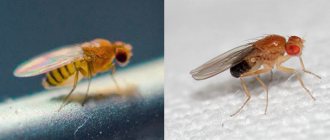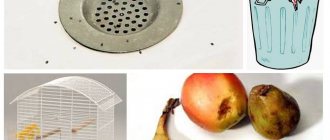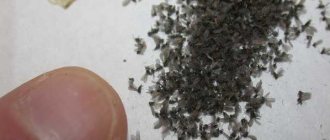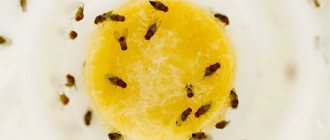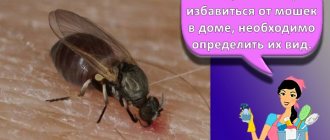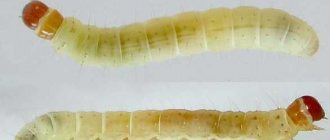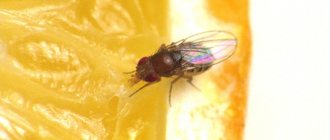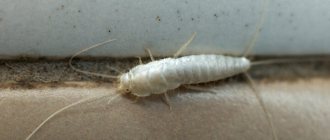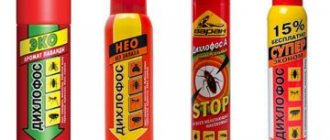Signs of a pest
The onion fly or mite can cause serious damage to the crop, with the larvae of this insect being the most dangerous.
They get into the inside of the bulb and eat it away from the inside, after which the plant damaged by the pest quickly withers and rots. Most often, this parasite feeds on onions, chives, and trumpets, severely damaging seedlings, seeds, or sets. Less often it occurs on leeks, which today enjoy great success among gardeners, and garlic.
It is quite difficult to see the larvae with the naked eye, since they are most often found in the ground. However, you can determine that they have begun to destroy the plantation by the “appearance” of the garden crops:
- plants grow poorly;
- garlic or onion feathers turn yellow, wither or dry out;
- garden crops emit a strong and unpleasant aroma;
- Instead of being hard, the plant heads become soft and sluggish in one or more places, and rot appears on them.
It is also worth knowing that the onion fly damages plantings, both in open ground under the sun’s rays and in a greenhouse. In a young plant, it sucks the juice from the soft, juicy and tender leaves. If the parasite population has increased, then a large number of plants with leaves that have lost turgor, twisted into a spiral and with yellowed edges will appear in the garden.
Onions of the second year of planting, among other things, are damaged by leaves and seeds. In closed ground, this pest can also attack cucumbers, causing serious damage to the future harvest.
Folk remedy
The easiest way to poison midges in the house is with proven folk remedies. A growing tomato on the windowsill, boiling clove oil, camphor vapor, verbena will help - all these smells repel midges from the house. An empty soda bottle left in a room overnight will attract most flying insects around the house. You can also try using traditional methods of catching midges: using a vacuum cleaner and sticky tape.
- One of the most well-known ways to force the midge and its offspring to find a different habitat and leave violets, aloe and dracaena alone is to buy several dozen boxes of matches in the store, which need to be stuck into the ground in pots with their heads. Try it, it definitely won't get any worse.
- It is also recommended not to water the plants for some time or to water them extremely moderately. In this case, the earth will dry out and the larvae that live in it will die. This will disrupt the population recovery cycle.
- Adults should also be dealt with mercilessly, because they reproduce several times throughout their lives. Many people use a regular vacuum cleaner for destruction. The process turns out to be fascinating; a certain number of flies are actually caught. But still, it is unlikely that it will be possible to solve the problem 100%, which does not negate the opportunity to try to act this way.
When talking about how to get rid of small flies at home, you need to mention a simple preventive measure that will prevent the appearance of insects - pour sand in a layer of about 1 cm into pots with plants or place small pebbles on the ground. Do this - even if prevention doesn’t work, the potted plants will look interesting.
Many people make traps of various designs into which the bait is detected. There are a great many options for such traps. Let us describe the simplest and most effective method:
- take a deep plate, pour apple cider vinegar into it - fill the plate about a third or a little more;
- dilute the vinegar with 100 ml of water, from the tap, it doesn’t matter;
- add a drop of ordinary liquid detergent to the resulting solution - no need to buy any special one, use the one you have;
- the mixture needs to be stirred thoroughly, for which a regular spoon is quite suitable;
- then cover the plate with its contents with cling film and wrap it, making sure that the liquid does not spill (you can use any film, just cling film - it’s more convenient than others);
- We pierce the surface of the film above the solution with a sharp, but not thick object (an ampoule of a regular ballpoint pen will do) - we make holes at a distance of approximately 2 - 3 cm from one another;
- we install a trap in the habitat of insects, they will penetrate the holes and fall into the solution, which will kill them.
Now you know how to get rid of flies at home using folk remedies. Try it - and you will definitely succeed! You should use industrially produced repellents only as a last resort.
Save it so you don't lose it ;)
The three most effective ways to deal with annoying midges
1 way. Industrial insecticides
In the event that general cleaning does not give the expected result, and harmful flies continue to scurry around the apartment, you, of course, can poison them with some kind of insecticidal aerosol, but the same dichlorvos, for example, is allowed to be used only in the toilet and living rooms, It is unacceptable to use such a toxic pesticide in the kitchen.
In areas where food is stored or prepared, it is better to use factory-made adhesive tapes to combat midges. Unfold and hang a couple of Velcro strips under the kitchen ceiling, and the very next day you will see that the number of small “saboteurs” secretly sneaking into your home has decreased significantly.
A fumigator can also be an excellent way to solve the problem of fly infestation. Fill this device with a special plate that acts on flies, or attach a reservoir with anti-fly liquid to it, turn on the unit all night, and in the morning you will not find a single fruit fly in your house.
Method 2. Homemade traps
Fruit flyers can be fought not only with chemicals, but also with safer, but no less effective folk remedies, which include the homemade traps described below.
Drunken trap. Flies love beer and dessert wine. Place an open, unwashed beer or liquor bottle on the kitchen counter. After a couple of hours, a large number of fruit flies will gather in it, flocking to an unexpected feast, all you have to do is plug the cap of the vessel full of midges and take it to the trash heap.
Apple trap. No less than sweet alcoholic drinks, fruit flies love apples. Taking advantage of this weakness, you can build a very effective trap, in which natural apple cider vinegar will play the role of bait. To make such a trap, take a half-liter jar, fill it a quarter full with warm water, pour a spoonful of natural apple cider vinegar into the water, the smell of which has a mesmerizing effect on midges, and add a couple of drops of shampoo or dishwashing liquid. Attracted by the aroma of your favorite fruit, the midge will fall into the water, and the “sticky” soap film formed on the surface of the liquid will not allow it to fly back up.
3 way. Repellents
If you don't have time to build traps, try scaring away unwanted guests with some kind of unpleasant smell. As such “horror stories” you can use:
- camphor, the smell of which all flies and mosquitoes really dislike. Throw a pinch of this substance into a heated dry frying pan and, as soon as its crystals begin to emit a characteristic wormwood aroma, immediately remove the vessel from the stove and walk with it throughout the apartment. Having smelled the smell of camphor, the flies will be forced to retreat.
- garlic - garden midges are afraid of the smell of this plant, so they can repel flies that have chosen flowerpots with indoor plants. Cut a few cloves of garlic into slices, place them on the surface of the substrate in flower pots, and the midges will soon leave their homes.
- cloves, the rich aroma of which plunges midges into panic. Place a dessert spoon of clove buds in a small ladle, fill them with a glass of water, and place an impromptu aroma lamp on the stove. When the liquid in the ladle begins to boil, a thick spicy spirit will spread throughout the apartment, which will disperse the “stray” guests.
Where do house flies come from and how to get rid of them?
The small black flies that so annoy housewives are extraordinary insects. The unique ability of these malicious flying creatures to appear as if out of nowhere gives them a certain mystical aura. However, the secret of the appearance of swarms of midges in hermetically sealed apartments has nothing to do with magic.
We suggest you read: How to get rid of carpet fleas using insecticidal and improvised means
Drosophila flies, of course, do not have the phenomenal gift of seeping through walls. In fact, midges end up in tightly sealed rooms along with food brought from outside, and the larvae and eggs of fruit flies can hide not only in vegetables and fruits, but also in mushrooms, cereals and garden flowers.
Each fly individual does not live long. Appearing into the world at dawn, it dies in the evening of the same day, but if there is food supply for it in the apartment, namely a supply of spoiled vegetables and fruits, the wine fly manages to lay a huge number of eggs on them within a day. Thus, the number of midges begins to increase exponentially, however, in fairness, it should be noted that in winter fruit flies do not reproduce as actively, but if you do not fight them, even in cold weather they can fill the entire house in a few days.
In addition to rotten fruits, midges love indoor flowers, or rather, the moist soil in which they grow. In addition, the proliferation of midges that have entered the house is facilitated by stagnant water in the aquarium, dampness in plumbing areas, dirt in pet cages, leaking sewer pipes, dishes that have not been washed for several days, and garbage forgotten in the kitchen.
Therefore, if you have fruit or flower flies in your home, before you start poisoning uninvited guests, try to eliminate their “tavern” first. To do this, first of all, remove all food from the table and wash dirty dishes, then inspect the refrigerator and inspect the kitchen cabinets. If you find any rotten fruits or moldy cereals there, immediately take them to the trash bin, and at the same time take with you the garbage that was left in the bucket.
When you have finished cleaning up the kitchen, to eliminate dampness, ventilate the apartment, clean the aquarium, loosen the soil in the flowerpots and drain the water from their trays.
At the end of the cleaning, vacuum the floors throughout the house and at the same time check if there is an apple core lying around in some secluded place.
Fertilizer and ammonia
The most effective means of pest control, according to experienced gardeners, is ammonia. A solution is prepared from it at the rate of 3 tbsp. l. ammonia in a bucket of water and water the soil well in the evening. Treatment should be carried out 3 times at monthly intervals. This is due to the fact that during the season the insect can colonize the site 3 times. And the nitrogen contained in ammonia is needed by onions as fertilizer. It nourishes the seedlings, gives them strength and prevents yellowing of the feathers.
Another effective remedy is ash. It can be wood ash or dead weeds. It is diluted with water, and the resulting product is used to water the beds with bulbous crops. You can add manure, tobacco dust, and powdered red pepper to the solution. Ash, like manure, fertilizes the soil and repels the onion fly.
Manure and peat can be applied to the soil before planting: the number of larvae and pupae will decrease several times.
Description
The onion midge is a small insect that is very similar in appearance to the ordinary indoor fruit fly midge that lives in the kitchen. Its characteristic features are a small oval-shaped body, the length of which does not exceed 5-8 mm, as well as an ash-yellow color with a greenish tint. In the photo you can see what an onion midge looks like.
Onion midge Pests begin active motor activity with the beginning of cherry blossoms, having previously led a sedentary lifestyle. In the first month of summer, females rush to lay eggs (up to 10 pieces), placing them on young bulbous shoots.
On a note!
After 7-8 days, larvae are born. They feed on the pulp of the bulb, gnawing out entire voids inside and thereby destroying the plant. Because of this, green bulbous feathers begin to turn yellow and dry, and the root system of the plant rots.
After 3 weeks, the stronger larvae move into the soil layer to pupate. And after 15-20 days the first offspring of onion flies will see the light. Depending on weather conditions, 2-3 such generations are hatched during the season.
Prevention of pests in the garden
The onion fly causes a lot of trouble for gardeners. To get rid of the pest, it is not necessary to use pesticides, some of which end up in the onion and are subsequently used as food.
Planting carrots and onions together
- You can use a solution based on laundry soap to treat the area. 50 g of crushed soap per bucket of water is enough.
- A proven way to get rid of midges over the years is to alternate rows of onions and carrots in the garden. The onion fly does not tolerate carrot phytoncides.
- The pest is afraid of the smell of pine needles, as well as mint, tomatoes, valerian and wild rosemary. To do this, you need to treat the onion beds with infusions of plants. It is necessary to spray before the pest begins to fly, since the product only has a repellent effect, but it is not an insecticide.
Treating onions with saline solution from a sprayer
- You can fight onion fly with a solution of regular salt. To do this, make a solution of 1/3 pack of salt per 10 liters of water. The first treatment should be carried out when the sprouts reach 5 cm. After 2 weeks, the treatment is repeated with a more saturated solution (1/2 pack of salt per 10 liters). The last time is sprayed after three weeks with a solution of even stronger concentration (2/3 packs of salt per 10 liters). This method is very effective, but degrades the quality of the soil. Direct watering should be avoided; it is better to use a sprayer. After treatment, the salt should be washed off from the seedlings; after a few hours, the onion should be watered with clean water.
- In order to get rid of the pest, crop rotation must be observed. You should not plant onions in the same place for more than 3-4 years.
Tobacco dust against pests
- A good remedy for midges on onions is tobacco dust. It can be used dry, sprinkled between rows, for each square. meter should take a tablespoon of dust. It also helps if you water the onions with a solution of a bucket of hot water and 200 mg of tobacco dust. The solution must be left for two days and the beds must be irrigated 2 times at weekly intervals.
- You can also use a decoction of dandelion root for onion fly. To prepare a folk remedy, you need to collect 200 g of roots and pour a liter of boiling water. After a few hours, add 9 liters of water.
- A solution of potassium permanganate also works well to get rid of the pest. To do this, add manganese to a bucket of water until a pinkish solution forms, and add tbsp. a spoonful of ammonia, 3 g of boric acid, 3 drops of iodine. Water at the root.
- Wood ash not only helps to remove onion flies, but also perfectly fertilizes the soil. You can regularly sprinkle the garden bed with it.
- It is also good to treat the seed in a manganese solution, and treat the nigella with insecticides. To reduce the number of pests, it is recommended to dig the soil deeply in the fall.
Bazudin 20 g
- In mid-May, add Bazudin or an analogue to the soil. To obtain the product, you need to take 30 ml of the drug for half a kilogram of sawdust or sand, mix and apply to the soil. This amount is enough to treat an area of 20 square meters.
- You can also add peat or manure to the soil. This will significantly reduce the number of pest larvae and pupae.
- Before planting, soak the onions for 15 minutes in a pale pink, warm solution of potassium permanganate;
- Plant alternating rows of onions and carrots, tomatoes or wild rosemary. The onion fly does not like these crops.
- Use crop rotation: do not plant in the same place for more than 4 years. During the break, grow cucumbers, tomatoes, and cabbage in this place.
The choice of processing method is made based on personal preferences.
You can treat the area with chemical insecticides or folk remedies prepared with your own hands. The main thing is that preventive measures are taken in a timely manner, since delay can lead to the loss of the crop.
Onion midge information
It is not difficult to distinguish insects from other representatives of this class. Onion midges have the following characteristic features:
- small size within 1-3 mm;
- oval shaped body;
- slow, leisurely flight;
- two symmetrically located wings and eight legs;
- their color is in the yellow-brown palette; very rarely they can be black or orange.
You can take a closer look at the onion midge in the photo posted on the website. Pests do not pose a danger to humans, they do not bite, do not carry any infection, but have the ability to multiply quickly. The female lays eggs only on the surface of spoiling fruits and vegetables, which the larvae then feed on.
Important! When storing onions in dark and warm places, especially in a plastic bag, they begin to rot. This creates favorable conditions for the spread of onion midges. It not only spoils the vegetables and fruits in the kitchen, but can also be found in sweets or a pot of a houseplant. At the first sign of pests appearing on indoor plants or food products, you need to start fighting them in order to get rid of them forever.
How to get rid of onion midge
With the onset of warm days, nature wakes up: dandelions, cherries and lilacs bloom. Various harmful insects, including onion midges, also awaken after hibernation. In a matter of days, annoying winged pests can destroy plantings, and with them the hope for a future harvest. You will learn how to get rid of onion midges from this article.
Description
The onion midge is a small insect that looks very similar to an ordinary house midge. Its characteristic features are a small oval-shaped body, the length of which does not exceed 5-8 mm, as well as an ash-yellow color with a greenish tint. In the photo you can see what an onion midge looks like.
Onion midge
On a note!
After 7-8 days, larvae are born. They feed on the pulp of the bulb, gnawing out entire voids inside and thereby destroying the plant. Because of this, green bulbous feathers begin to turn yellow and dry, and the root system of the plant rots.
After 3 weeks, the stronger larvae move into the soil layer to pupate. And after 15-20 days the first offspring of onion flies will see the light. Depending on weather conditions, 2-3 such generations are hatched during the season.
Onion midges are also quite common in apartments. They end up in the house along with a rotten onion that was brought from the market or store. Therefore, when purchasing vegetables, it is necessary to carefully inspect them. You won’t have to get rid of harmful insects if you carefully select and discard damaged bulbs intended for planting. For preventive purposes, the selected material should be treated with potassium permanganate or hot water.
Fighting onion midge
Midges on onions
On a note!
It is impossible for onions to grow in the same place every year. This can cause the accumulation of not only onion midge larvae in the soil, but also other pests.
If midges from onions have managed to appear due to improper storage, you can get rid of the pests in the following ways.
Pesticide
Chemicals will help you quickly get rid of onion midges in your garden. The following brands of preparations are used to spray onions:
- Terradox;
- Aktara;
- Karate Zeon;
- Raptor;
- Maksim;
- Fly eater.
The products are used in accordance with the instructions for treating onion fields.
Pesticides against midges
Folk remedies
You can also get rid of harmful insects using folk recipes. It is much safer to fight onion midges this way.
After all, one should take into account the fact that feathers and bulbs are used for food
- Laundry soap. Regular laundry soap will help get rid of onion midges. It is grated on a coarse grater and combined with water (50 g of product per 10 liters of water). The resulting solution is sprayed onto the bulbous beds.
- Carrot. To prevent onion midges from appearing, it is enough to alternate onion beds with carrots when planting. The phytoncides of these plants mutually protect each other from pests.
- Dandelion. You can even get rid of the pest with the help of dandelion. An infusion is prepared from the crushed roots of the plant, which is then used to spray the beds twice a month.
- Potassium. Potassium can also remove midges. The beds of onions, garlic or carrots are irrigated with the product once a week.
- Salt. Salt is no less effective in combating harmful insects. To prepare the solution, you need to dilute 300 g of the product in 10 liters of water. To get rid of midges, barely emerging onion feathers are treated with the resulting mixture.
- Ash. A mixture of wood ash, tobacco dust and ground black pepper is used to treat onion beds during periods of high insect activity.
What to do if you find onion midges?
How to get rid of onion midges is a paramount question, and you need to start solving it by finding a place for their active reproduction. The main thing is to leave pests without food and a breeding ground for their offspring. The procedure will be as follows:
- Throw away spoiled onions, carefully sorting through all available vegetables.
- Place the onions in the refrigerator without signs of rotting or spoilage, placing them in small portions in plastic bags.
- If it is not possible to put onions and other root vegetables in the cold, they should be stored in boxes with sawdust, or, as a last resort, in well-ventilated fabric bags.
- Remove all fruits, especially citrus fruits, out of reach of midges.
- Throw out garbage on time, at first - 1-2 times a day.
- Wash dirty dishes immediately after eating.
- Limit the access of insects to water - they also need it for life. To do this, you should close all taps so that they do not drip, leave sinks dry, do not store water on the table, and thoroughly dry clean dishes.
- Remove and clean siphons a couple of times a week and use disinfectants to clean the sewer system.
- Wash your pets' cages regularly and prevent food residues from being left there.
IMPORTANT: If there are plants in the apartment, they also need to be cleaned, because insects can settle on them for lack of other food. You should reduce the frequency of watering and stop pouring tea leaves on the ground. If necessary, you can spray the flowers with a weak solution of potassium permanganate.
Tips to help you quickly get rid of onion midges:
Biological portrait
Photo of onion fly
Appearance
Like many pests, the onion fly is a small insect, not exceeding 7 mm in length. The color is gray closer to ash. Visually, the insect is very similar to an ordinary fly. Its years begin with the establishment of consistently warm weather, that is, the last ten days of April or the first days of May. Another external marker that gives the farmer a signal to be vigilant is cherry blossoms. It is at this time that the insect begins its seasonal development.
A fly may have wings with or without 2-3 longitudinal veins. But in any case, the edges are “shaped” by a fringe of their thin long hairs. The abdomen is segmented - 11 parts.
Reproduction
Reproduction occurs through egg clutches, which the female lays nearby onion plants. They are elongated white, up to 10 mm long. Hatching occurs after 3-8 days depending on external conditions. The eggs hatch into larvae that immediately bite into the bulb. The routes of penetration can be different - through the base of the leaf, through the bottom where the roots grow. The larvae of the onion fly, remaining in this form for the entire period, live inside the bulbs, devouring the internal tissues. It is interesting that if many individuals come out at the same time, then they stay in a group and critical damage is caused to the plant. During the transition period from a stationary larva to an adult, there is an intermediate stage of development when the insect remains in the analogue of a pupa with the rudiments of wings.
The female is very fertile - if detected, emergency measures are needed
Exit of young animals
The insect stays in larval form for about 3 weeks. After this period, the larva leaves the plant and goes into the ground next to the eaten bulb to pupate. This phase lasts 20 days, after which young flies emerge from the pupa. Based on these data, the logical conclusion is updated that the fight against onion fly should begin as early as possible. In practice, there are cases when this parasite destroys 100% of the plants on an onion plantation. By the way, it also attacks garlic.
How dangerous is the onion fly?
The onion fly is an insect similar to the familiar house fly. Its length reaches 8 mm, the fly is colored yellowish-gray. Distributed in almost any climatic region. The fly itself does not cause much harm; its larvae pose a danger when growing onion vegetables. During her life, one female is capable of giving birth to up to fifty larvae, from which new flying insects subsequently appear.
Externally, the onion fly is the most common fly
The fly lays eggs in any irregularities on the surface of the bulbs; each clutch contains at least a dozen white eggs, which are slightly elongated in shape, their size is about 1 mm. In addition to the most common onion we are used to, it damages the bulbs of any other onion plants (leeks, spring onions, family onions, and even bulbous flowers such as daffodils or tulips).
The larvae appear within a week; they look like worms and almost immediately grow up to 1 cm in length. Near the head, the body of the larva is slightly narrowed. The entire “family” of larvae simultaneously gnaws through the flesh of the onion, which is why it looks like a “cave” in it. The lifespan of flies in the larval stage is 3 weeks, after which they crawl into the ground to pupate, and after another 3 weeks young flies fly out.
Onion fly larvae are quite large and easily visible
The onion fly damages plantings throughout the gardening season. The first oviposition is possible as early as April, from which a new generation of insects appears in mid-summer, which are soon capable of reproducing. The fly overwinters at a depth of about 20 cm in the form of pupae.
The first signs of damage to plantings are:
- wilting of onion leaves, despite sufficient moisture;
- painting the tips of the leaves first white, then yellow, followed by drying;
- putrid smell from the onion bed.
If there is any doubt about the diagnosis, pull out a couple of bulbs: if the problem is a fly, even without glasses you can see small white larvae.
Causes of midges
Before you find out how to get rid of fruit flies, you need to figure out why they got into your apartment. The midge won't start on its own. There are reasons for everything, and there may be several of them.
- Fruit midges lay their eggs in vegetables or fruits that we bring into our home with purchases. Moreover, over time, the larvae acquire the same color as that of the fruit on which they develop. Therefore, it is not always possible to detect them. Most often, this problem is faced by people who store vegetable supplies for the winter in their homes. One rotten potato or onion, which is located at the bottom or in the middle of the bag, will do its “rotten job”. Moreover, you will not even understand where these midges come from, and at the same time their number will increase exponentially every day.
- In summer, insects fly freely into open entrance doors and windows.
- If there is a “living area” in your house, this can also cause the appearance of flies. Plant food for animals that begins to rot is a very favorable breeding ground for fruit flies.
- Even indoor flowerpots with flowers sometimes cause midges to appear in your apartment. Many gardeners feed and mulch their plants with tea leaves, which fruit flies adore. And some people, out of ignorance, simply overwater their indoor flowers with frequent watering, which leads to waterlogging and rotting of the top layer of soil and the plants themselves. For prevention, indoor plants can be watered with a pink solution of potassium permanganate. It is also good to stick 3-4 matches into the soil, gray side down.
IMPORTANT! A fly that emerges from a larva is capable of fertilization within 8 hours. She turns into an adult on the 8th - 10th day, and in 2 months of her life, the female will lay from 200 to 2000 eggs, from which at the optimal air temperature (room temperature) the larvae will hatch and the process will be repeated again
This can turn your home into an infestation of flies.
Where do midges come from?
Despite their small size, insects can fly considerable distances, so they can end up in any apartment. They get to new housing in different ways, here are the main ones:
- Insect eggs may be present on vegetable and fruit products that were bought in a store, at the market, brought from a dacha, or taken from friends.
- It is possible that one or a couple of individuals accidentally enter through a window or door, after which they lay eggs and “start” the reproduction process.
- Pests also enter through ventilation from neighbors.
- To reproduce, insects need a nutrient medium - warm, rotting foods, spilled juices, pieces of plant food lying around, used tea bags, sewerage with an abundance of plaque. Female small flies can also lay eggs on the bedding and food of pets, for example, when their cages are rarely cleaned. Midges love wet, unwashed kitchen rags and napkins.
Midges from onions breed especially well, because if stored improperly, this vegetable begins to rot quickly. Many housewives have onions in a dark, warm place, wrapped in a plastic bag, and this is an ideal condition for them to rot.
Therefore, midges on onions multiply at tremendous speed, and will soon fly throughout the kitchen in dozens and hundreds.
Onion fly: how to fight it?
Fighting onion fly in the garden is a long and labor-intensive process, which does not always allow you to save the harvest. Therefore, it is wiser to prevent the appearance of the pest in the garden. But first, let's talk about methods of struggle.
Onion flies can be fought with traditional methods and with the help of modern chemistry.
Traditional methods
Our ancestors long ago figured out how to get rid of onion flies. Experienced gardeners know about traditional methods of pest control and successfully use them. At the same time, all gardeners agree that spraying onion beds with infusions, whose aromas repel the pest, is considered the most effective.
It is worth noting that this method of control is not only effective, but also completely safe for both the plants themselves and humans. For this reason, spray onions with solutions of plants with a spicy odor.
Another effective way to combat the pest is to treat onion beds with ammonia. To do this, you need to dissolve 3 tablespoons of alcohol in 6 liters of water. The resulting solution should be watered onions 3 times during the summer with an interval of 1 month between waterings.
Pay attention to the fact that watering with ammonia solution is beneficial for onions. Ammonia contains nitrogen, which promotes active protein production. You can also expel onion flies from the garden using the following methods:
You can also expel onion flies from the garden using the following methods:
- A mixture of manure and peat. This remedy is not able to completely rid the garden of onion flies, but it can significantly thin out the ranks of the pest. In addition, this mixture is an organic fertilizer. Its use will have a positive effect on onion growth.
- Dandelion infusion. It is not difficult to prepare: 200 g of plant roots need to be infused in 10 liters of water for 7 days. Then the resulting solution can be safely poured onto the beds. True, this needs to be done at intervals of 2 weeks in equal portions. The smell emitted by the solution will drive out flies in a couple of days.
- Table salt solution. This is perhaps the easiest pest control remedy to prepare. To prepare it, you need to dissolve one glass of salt in 10 liters of water. The resulting solution should be used to water the plants affected by the larvae. In this case, there should be at least one glass of saline solution per plant.
- Soap solution. This pest control product is also very simple to use: dissolve 50 g of soap in 10 liters of water and pour the resulting solution onto the beds.
Modern chemistry
Many gardeners consider traditional methods to be insufficiently effective and prefer to use modern chemistry to combat the pest. And this despite the fact that chemical preparations are often much more expensive than folk remedies. In addition, chemicals can harm the onion harvest. However, the risk is justified by the absolute effectiveness of the chemicals.
How to treat onions against onion flies? Experts recommend the following drugs:
- "Aktara". This is a strong insecticide designed to combat a wide variety of pests. Its peculiarity is its cost-effectiveness and long-lasting protective effect.
- "Zemlin." This product should be used directly when planting onions. It is introduced into the soil only in mixtures with sawdust and sand.
- "Tarantula". A very powerful drug that effectively destroys not only adult flies, but also larvae. A one-time use of this drug protects the beds from the pest for 21 days.
- "Extraflor". This biological product is a tobacco extract. This is a fairly strong remedy that allows you not only to defeat the pest, but also to avoid poisoning the crop with chemicals.
How to fight onion flies at home
An onion fly may appear in your apartment if you grow onions for greens on a windowsill, or if you store the harvest at home in winter. The appearance of midges can occur if garden soil contaminated with pest larvae was used for cultivation. Either the infected bulbs were inadvertently planted on greenery or left for storage indoors.
Fly control measures are similar to those used in garden beds. It is better to use traditional methods, they are harmless and no less effective. At home, the use of insecticides is undesirable. They are used as a last resort and only taking precautions.
To prevent the reproduction of midges, dried bunches of tansy, wormwood, and marigolds are hung on the walls or laid out on shelves. Do not lose your vigilance, periodically check your onion supplies and remove affected bulbs in a timely manner.
If midges do appear from the onion, use bait near the place where the onion is stored. Place slices of apples, pears, tangerine or orange peels in plastic bags or in a jar closed with a lid with small holes. Midges fly to their smell. All that remains is to close the jar, tie the bag and throw it away.
The onion fly is a parasite that is distinguished by its fertility and gluttony. If you do not start a timely fight against the insect, it will quickly destroy the bulbous plants. It lays larvae inside the bulb, which quickly develop, and in the process completely eat the plant.
Therefore, before planting, you should think in advance about how to get rid of onion midges so that their appearance does not come as a surprise. The appearance of the creatures can easily be confused with an ordinary fly, but the harm from them will be much greater.
